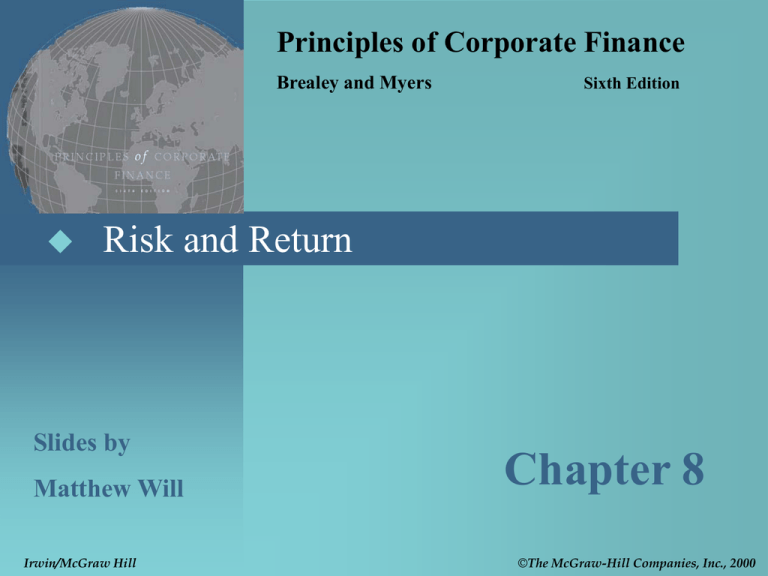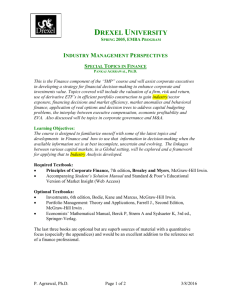ch8
advertisement

Principles of Corporate Finance Brealey and Myers Sixth Edition Risk and Return Slides by Matthew Will Irwin/McGraw Hill Chapter 8 ©The McGraw-Hill Companies, Inc., 2000 8- 2 Topics Covered Markowitz Portfolio Theory Risk and Return Relationship Testing the CAPM CAPM Alternatives Irwin/McGraw Hill ©The McGraw-Hill Companies, Inc., 2000 8- 3 Markowitz Portfolio Theory Markowitz was the first person to observe that there are no securities that are perfectly positively or negatively correlated. Thus, all stocks fall in the middle range and the risk of a PF will always be less than the simple weighted average of the individual risks of the stocks in the PF. Correlation coefficients make this possible. Irwin/McGraw Hill ©The McGraw-Hill Companies, Inc., 2000 8- 4 Markowitz Portfolio Theory Expected Returns and Standard Deviations vary given different weighted combinations of the stocks. Expected Return (%) McDonald’s 45% McDonald’s Bristol-Myers Squibb Standard Deviation Irwin/McGraw Hill ©The McGraw-Hill Companies, Inc., 2000 8- 5 Efficient Frontier •Each half egg shell represents the possible weighted combinations for two stocks. •The composite of all stock sets constitutes the efficient frontier. Expected Return (%) Standard Deviation Irwin/McGraw Hill ©The McGraw-Hill Companies, Inc., 2000 8- 6 The efficient frontier represents the set of portfolios that will give you the highest return at each level of risk. Portfolios on the efficient frontier are efficient in that there is no other combination of stocks that offer that high a return for the risk taken. Irwin/McGraw Hill ©The McGraw-Hill Companies, Inc., 2000 8- 7 Efficient Frontier Example Stocks ABC Corp Big Corp s 28 42 Correlation Coefficient = .4 % of Portfolio Avg Return 60% 15% 40% 21% Standard Deviation = weighted avg = 33.6 Standard Deviation = Portfolio = 28.1 Return = weighted avg = Portfolio = 17.4% Irwin/McGraw Hill ©The McGraw-Hill Companies, Inc., 2000 8- 8 Efficient Frontier Example Stocks ABC Corp Big Corp s 28 42 Correlation Coefficient = .4 % of Portfolio Avg Return 60% 15% 40% 21% Standard Deviation = weighted avg = 33.6 Standard Deviation = Portfolio = 28.1 Return = weighted avg = Portfolio = 17.4% Let’s Add stock New Corp to the portfolio Irwin/McGraw Hill ©The McGraw-Hill Companies, Inc., 2000 8- 9 Efficient Frontier Example Stocks Portfolio New Corp s 28.1 30 Correlation Coefficient = .3 % of Portfolio Avg Return 50% 17.4% 50% 19% NEW Standard Deviation = weighted avg = 31.80 NEW Standard Deviation = Portfolio = 23.43 NEW Return = weighted avg = Portfolio = 18.20% Irwin/McGraw Hill ©The McGraw-Hill Companies, Inc., 2000 8- 10 Efficient Frontier Example Stocks Portfolio New Corp s 28.1 30 Correlation Coefficient = .3 % of Portfolio Avg Return 50% 17.4% 50% 19% NEW Standard Deviation = weighted avg = 31.80 NEW Standard Deviation = Portfolio = 23.43 NEW Return = weighted avg = Portfolio = 18.20% NOTE: Higher return & Lower risk Irwin/McGraw Hill ©The McGraw-Hill Companies, Inc., 2000 8- 11 Efficient Frontier Example Stocks Portfolio New Corp s 28.1 30 Correlation Coefficient = .3 % of Portfolio Avg Return 50% 17.4% 50% 19% NEW Standard Deviation = weighted avg = 31.80 NEW Standard Deviation = Portfolio = 23.43 NEW Return = weighted avg = Portfolio = 18.20% NOTE: Higher return & Lower risk How did we do that? Irwin/McGraw Hill ©The McGraw-Hill Companies, Inc., 2000 8- 12 Efficient Frontier Example Stocks Portfolio New Corp s 28.1 30 Correlation Coefficient = .3 % of Portfolio Avg Return 50% 17.4% 50% 19% NEW Standard Deviation = weighted avg = 31.80 NEW Standard Deviation = Portfolio = 23.43 NEW Return = weighted avg = Portfolio = 18.20% NOTE: Higher return & Lower risk How did we do that? DIVERSIFICATION Irwin/McGraw Hill ©The McGraw-Hill Companies, Inc., 2000 8- 13 Efficient Frontier Return B A Risk (measured as s) Irwin/McGraw Hill ©The McGraw-Hill Companies, Inc., 2000 8- 14 Efficient Frontier Return B AB A Risk Irwin/McGraw Hill ©The McGraw-Hill Companies, Inc., 2000 8- 15 Efficient Frontier Return B AB A N Risk Irwin/McGraw Hill ©The McGraw-Hill Companies, Inc., 2000 8- 16 Efficient Frontier Return B ABN AB A N Risk Irwin/McGraw Hill ©The McGraw-Hill Companies, Inc., 2000 8- 17 Efficient Frontier Goal is to move up and left. Return WHY? B ABN AB A N Risk Irwin/McGraw Hill ©The McGraw-Hill Companies, Inc., 2000 8- 18 Efficient Frontier Return Low Risk High Return Risk Irwin/McGraw Hill ©The McGraw-Hill Companies, Inc., 2000 8- 19 Efficient Frontier Return Low Risk High Risk High Return High Return Risk Irwin/McGraw Hill ©The McGraw-Hill Companies, Inc., 2000 8- 20 Efficient Frontier Return Low Risk High Risk High Return High Return Low Risk Low Return Risk Irwin/McGraw Hill ©The McGraw-Hill Companies, Inc., 2000 8- 21 Efficient Frontier Return Low Risk High Risk High Return High Return Low Risk High Risk Low Return Low Return Risk Irwin/McGraw Hill ©The McGraw-Hill Companies, Inc., 2000 8- 22 Efficient Frontier Return Low Risk High Risk High Return High Return Low Risk High Risk Low Return Low Return Risk Irwin/McGraw Hill ©The McGraw-Hill Companies, Inc., 2000 8- 23 So far, we assume that all the securities on the efficient set are risky. Alternatively, an investor could easily combine a risky investment with an investment in a riskless security. The combination of the riskless asset and the risky asset produces a liner risk/return line. The introduction of a risk-free asset changes the Markowitz efficient frontier into a straight line (Capital Market Line). That is, CML can be viewed as the efficient set of all assets, both risky and riskless. Irwin/McGraw Hill ©The McGraw-Hill Companies, Inc., 2000 8- 24 Capital Market Line Return Market Return = rm Market Portfolio Risk Free Return . = rf Risk Irwin/McGraw Hill ©The McGraw-Hill Companies, Inc., 2000 8- 25 With riskless borrowing and lending, the PF of risky assets held by any investor would always be point A. Regardless of the investor’s tolerance for risk, he would never choose any other point on the efficient set of risk assets nor any point in the interior of the feasible region. Rather, he would combine the securities of A with the riskless assets if he had high aversion to risk. Irwin/McGraw Hill ©The McGraw-Hill Companies, Inc., 2000 8- 26 Notice that the standard deviation of returns is on the X-axis of the CML graph. Is this the relevant measure of risk? The standard deviation of expected returns measures a stock’s total risk. However, the risk that can be easily diversified should not be compensated for. If you want to plot return again risk, the risk measure must be the measure of risk influencing return. So, the proper relationship is return vs. systematic risk. Irwin/McGraw Hill ©The McGraw-Hill Companies, Inc., 2000 8- 27 Security Market Line Return Market Return = rm . Efficient Portfolio Risk Free Return = rf 1.0 Irwin/McGraw Hill BETA ©The McGraw-Hill Companies, Inc., 2000 8- 28 Security Market Line Return Market Return = rm Security Market Line (SML) Risk Free Return = rf 1.0 Irwin/McGraw Hill BETA ©The McGraw-Hill Companies, Inc., 2000 8- 29 The relationship between expected return and beta can be represented by the capital asset pricing model. Expected return on a security = rf + Beta of the security * [E(Rm)-rf ] Irwin/McGraw Hill ©The McGraw-Hill Companies, Inc., 2000 8- 30 Testing the CAPM Beta vs. Average Risk Premium Avg Risk Premium 1931-65 SML 30 20 Investors 10 Market Portfolio 0 1.0 Irwin/McGraw Hill Portfolio Beta ©The McGraw-Hill Companies, Inc., 2000 8- 31 Testing the CAPM Beta vs. Average Risk Premium Avg Risk Premium 1966-91 30 20 SML Investors 10 Market Portfolio 0 1.0 Irwin/McGraw Hill Portfolio Beta ©The McGraw-Hill Companies, Inc., 2000



